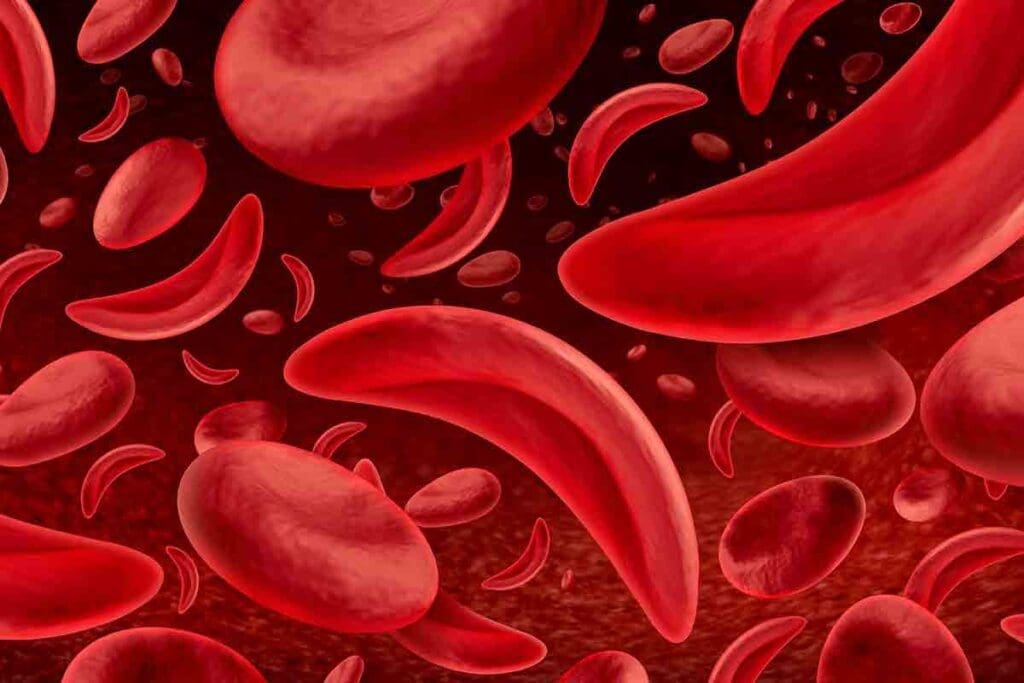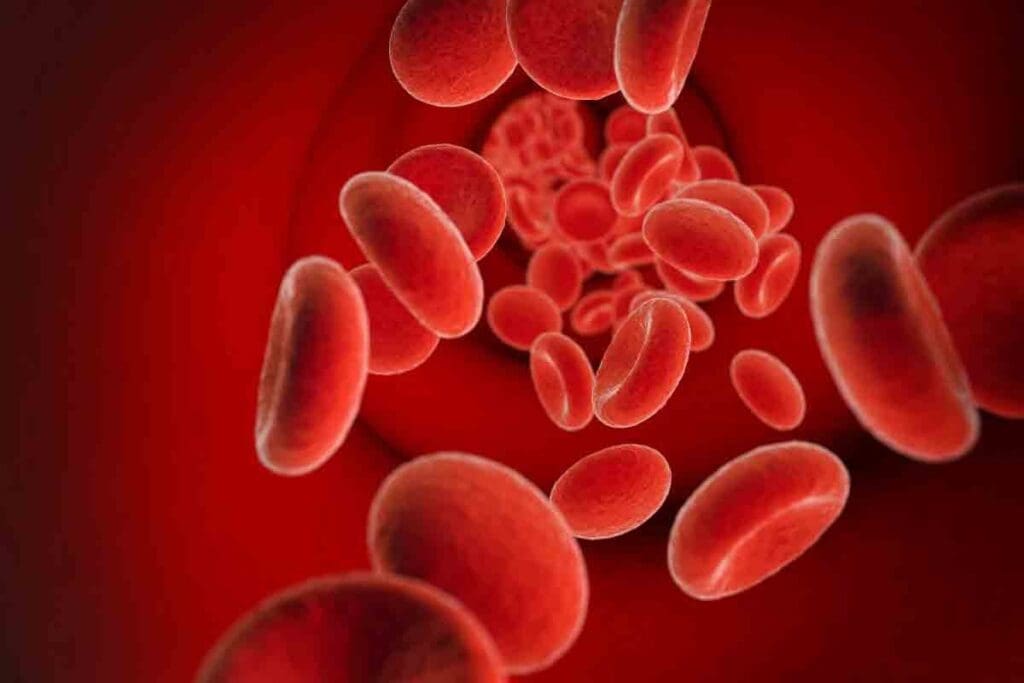Last Updated on November 20, 2025 by Ugurkan Demir

Abnormal red blood cells can come from many sources. This includes genetic changes, long-term diseases, and not getting enough nutrients. At LivHospital, we know how important it is to find and treat red blood cell disorders well.
These disorders can be simple anemia or serious diseases like leukemia. It’s key to know the common causes and related blood disorders. This helps doctors diagnose and treat them right.

Red blood cells are key to our health. They make sure our body’s tissues and organs get the oxygen they need. These cells carry oxygen from the lungs to the rest of the body and take carbon dioxide back to the lungs to be exhaled.
Normal red blood cells, or erythrocytes, have a unique biconcave disk shape. This shape helps them exchange gases efficiently. It also makes them flexible and able to move through narrow blood vessels.
The main job of red blood cells is to carry hemoglobin. Hemoglobin is a protein that picks up oxygen in the lungs and releases it to the tissues.
Hemoglobin is vital for red blood cells to carry oxygen. It’s made of four protein chains and a heme group with iron. The iron in hemoglobin is what makes blood red and is key for binding oxygen.
Red blood cells are made in the bone marrow through erythropoiesis. This process turns hematopoietic stem cells into mature red blood cells. Erythropoietin, a hormone from the kidneys, helps control this by making more red blood cells when oxygen levels are low.
Many things can affect how red blood cells are made. Nutritional intake, health, and certain medical conditions all play a role. For example, not enough iron, vitamin B12, or folate can lead to anemia.
| Factors Influencing RBC Production | Effect on RBC Production |
| Nutritional Deficiencies (Iron, B12, Folate) | Decreased production, potentially leading to anemia |
| Erythropoietin Levels | Stimulates production in response to low oxygen levels |
| Chronic Diseases | Can impair production or lead to abnormal RBCs |
Knowing how red blood cells are made and work is key to spotting problems. Issues with red blood cells can cause anemia, fatigue, and shortness of breath.
“The production and function of red blood cells are intricately linked to overall health, and abnormalities can have significant clinical implications.”
Hematologist

Understanding abnormal red blood cells is key to diagnosing and managing health issues. These cells can be caused by genetic mutations, nutritional deficiencies, or chronic diseases.
Abnormal red blood cells don’t look or count right, which affects how they work. They can be different shapes, like spherocytes, elliptocytes, or sickle cells. Or, they can be in too many or too few numbers, as in anemia or polycythemia.
Blood tests can find abnormal red blood cells. Tests like Complete Blood Count (CBC), peripheral blood smear, and reticulocyte count are used. They check the size, shape, and number of red blood cells.
Abnormal red blood cells can affect how well oxygen is carried and overall health. Anemia can cause less oxygen to reach tissues, leading to fatigue and weakness. Polycythemia can make blood thicker, raising the risk of heart problems.
Key impacts include:
Abnormal red blood cells can come from many sources. This includes genetic disorders and conditions we get later in life. Knowing why these problems happen helps us find who is at risk.
Red blood cell issues fall into two main groups: genetic and acquired. Genetic problems, like sickle cell anemia and thalassemia, are passed down from parents. These can be diagnosed early and have big health effects.
Acquired causes, however, come from things like not getting enough nutrients, having chronic diseases, or being exposed to toxins. For example, iron deficiency anemia happens when we don’t get enough iron. Knowing if a problem is genetic or acquired helps doctors figure out how to treat it.
How common red blood cell disorders are varies a lot. For example, sickle cell anemia is more common in people of African descent. Thalassemia is more common in people from the Mediterranean and Southeast Asia.
Here’s a table showing how common different red blood cell disorders are:
| Condition | Prevalence | Affected Populations |
| Sickle Cell Anemia | 1 in 500 African Americans | African, Caribbean, and South American populations |
| Thalassemia | 1 in 100,000 worldwide | Mediterranean, Middle Eastern, and Southeast Asian populations |
| Iron Deficiency Anemia | 2 billion people worldwide | Global, with higher prevalence in developing countries |
There are many things that can make someone more likely to get a red blood cell disorder. These include having a family history of these conditions, not getting enough nutrients, having chronic diseases, and being exposed to toxins.
For example, if someone has a family history of genetic blood disorders, they are more likely to get one. People who don’t have access to good food are more likely to get anemia because of nutritional deficiencies.
By knowing these risk factors, doctors can do more to prevent and treat red blood cell disorders. This helps keep people healthy and reduces the impact of these conditions.
We look at how genetic blood disorders impact red blood cells. We focus on the causes, symptoms, and how to manage these conditions. These disorders are inherited and affect millions worldwide. They can lead to serious health problems if not managed well.
Sickle cell anemia is a genetic condition where red blood cells change shape. This can block blood flow, causing pain, tiredness, and damage to organs over time. It’s caused by a mutation in the HBB gene, leading to abnormal hemoglobin.
Symptoms vary but often include pain episodes, infections, and anemia. Management includes preventive steps, pain relief, and sometimes blood transfusions.
Thalassemia is a genetic disorder affecting hemoglobin production. It causes anemia, fatigue, and other issues due to low hemoglobin. The severity depends on how many genes are affected.
Treatment involves regular blood transfusions, iron chelation therapy, and sometimes bone marrow transplantation.
Hereditary spherocytosis is a disorder where red blood cells are sphere-shaped instead of the usual disk shape. This shape affects their function and lifespan, causing anemia and other problems.
Management may include splenectomy, folate supplements, and monitoring for complications.
Understanding these genetic blood disorders is key to providing the right care. The table below summarizes important aspects of these conditions.
| Disorder | Cause | Symptoms | Management |
| Sickle Cell Anemia | Mutation in HBB gene | Pain episodes, infections, anemia | Pain management, blood transfusions |
| Thalassemia | Mutations affecting hemoglobin production | Anemia, fatigue | Blood transfusions, iron chelation |
| Hereditary Spherocytosis | Genetic defects affecting red blood cell membrane | Anemia, jaundice | Splenectomy, folate supplements |
Eating a balanced diet is key to keeping red blood cells healthy. If we don’t get enough nutrients, our red blood cells can become abnormal. This can affect how well these cells work in our body.
Iron deficiency anemia is the most common type of anemia. It happens when we don’t have enough iron to make hemoglobin. Hemoglobin is a part of red blood cells that carries oxygen.
Symptoms include feeling very tired, weak, and having trouble breathing.
| Causes | Symptoms | Treatment |
| Inadequate dietary intake, chronic blood loss, increased iron requirement | Fatigue, weakness, pale skin, shortness of breath | Iron supplements, dietary adjustments, addressing underlying causes |
Not having enough vitamin B12 and folate can cause megaloblastic anemia. This is when red blood cells are too big. These vitamins help make DNA, which is needed for red blood cells.
Other nutrients are also important for red blood cells. Vitamin B6 helps make hemoglobin. Copper is needed to make red blood cells. Vitamin E protects red blood cells from damage.
It’s important to eat enough of these nutrients to keep our red blood cells healthy. Eating a variety of foods helps us get all the nutrients we need.
Chronic diseases can greatly affect red blood cell production and function. This leads to various disorders. We will look at how kidney disease, liver disorders, and autoimmune diseases impact red blood cell health.
The kidneys are key in making red blood cells by producing erythropoietin (EPO). Kidney disease can disrupt EPO production. This can lead to fewer red blood cells and anemia.
Chronic kidney disease (CKD) raises the risk of anemia. As kidney function worsens, anemia becomes more common. Patients with CKD often need erythropoiesis-stimulating agents to manage anemia and keep red blood cell counts healthy.
The liver is crucial for red blood cell health. Liver disorders, like cirrhosis and hepatitis, can affect protein and lipid production. These are vital for the red blood cell membrane’s structure and function.
Liver disease can change red blood cell shape, making them more prone to destruction. It can also lead to toxin buildup, damaging red blood cells.
Autoimmune diseases happen when the immune system attacks the body’s own cells, including red blood cells. Conditions like autoimmune hemolytic anemia (AIHA) can destroy red blood cells. This results in anemia and other issues.
Treatment for AIHA often involves immunosuppressive medications to stop the immune system’s attack on red blood cells. In severe cases, blood transfusions may be needed to manage anemia.
Many infections and inflammatory conditions can harm red blood cells. These issues can make red blood cells work poorly. This affects their health and function.
Bacterial and viral infections can really hurt red blood cell production. For example, sepsis can cause anemia of inflammation. This means less iron and trouble making new red blood cells. Viral infections like HIV and hepatitis can also mess with the bone marrow.
Key Effects of Bacterial and Viral Infections:
| Infection Type | Effect on Red Blood Cells |
| Bacterial (Sepsis) | Anemia of inflammation, reduced iron availability |
| Viral (HIV, Hepatitis) | Impaired erythropoiesis, bone marrow suppression |
Chronic inflammation can really slow down red blood cell production. This is common in diseases like rheumatoid arthritis and chronic kidney disease. Inflammatory cytokines can stop erythropoiesis and cut iron levels, causing anemia.
“Chronic inflammation is a big reason for anemia in people with chronic diseases.”
Source: Journal of Clinical Hematology
Parasitic diseases, like malaria, directly harm red blood cells. Malaria parasites destroy red blood cells, causing hemolytic anemia. Other parasitic infections can also hurt red blood cell health and production.
Blood cancers, like leukemia and lymphoma, change red blood cells a lot. These diseases affect how red blood cells are made and work. This often leads to anemia and other problems.
Leukemia starts in the bone marrow and makes too many bad white blood cells. These cells take over and stop normal red blood cells from being made. This causes anemia and other issues.
Key effects of leukemia on red blood cells include:
Lymphoma affects the lymphatic system and can also mess with red blood cell production. Other cancers that spread to the bone marrow can do the same thing.
“The presence of cancer cells in the bone marrow can significantly alter the production and function of red blood cells, leading to various clinical manifestations.”
| Cancer Type | Impact on Red Blood Cells |
| Leukemia | Reduces production, increases destruction |
| Lymphoma | Affects lymphatic system, can impact RBC production |
| Metastatic Cancer | Disrupts normal RBC production in bone marrow |
Poikilocytosis is when red blood cells are not the right shape. It’s common in people with cancer. It can happen because of the cancer itself or because of treatments like chemotherapy.
It’s important to know how cancer affects red blood cells. This helps doctors give better care to cancer patients. By understanding these effects, doctors can find better ways to help patients.
An elevated red blood cell count can be caused by several factors. These include chronic hypoxia, dehydration, and polycythemia vera. Knowing these causes is key to managing the condition and avoiding complications.
Chronic hypoxia, or low oxygen levels, prompts the body to make more red blood cells. This is common in people with lung diseases like COPD.
Key factors contributing to chronic hypoxia:
A medical expert notes, “Chronic hypoxia leads to more red blood cells. This is the body’s way of trying to get more oxygen.”
“The body adapts to low oxygen levels by producing more red blood cells, which can lead to an elevated red blood cell count.”
Hematologist
Dehydration can make the blood more concentrated, raising the red blood cell count. This is due to hemoconcentration.
| Causes of Dehydration | Effects on Red Blood Cell Count |
| Inadequate fluid intake | Hemoconcentration |
| Excessive sweating | Relative polycythemia |
| Diuretic use | Increased blood viscosity |
Polycythemia vera is a rare blood disorder. It causes the body to make too many red and white blood cells, and platelets. It’s a type of myeloproliferative neoplasm.
Polycythemia vera makes blood thicker and increases clotting risk. Managing it means regular doctor visits and possibly reducing red blood cells through phlebotomy.
Key aspects of managing polycythemia vera:
To effectively manage red blood cell disorders, we need to understand their causes. Diagnosing these conditions involves looking at a patient’s medical history, doing a physical exam, and running lab tests. These steps help us find the root cause of the problem and plan the right treatment.
Managing these disorders requires a team effort. We use lab tests, medical history, and physical exams to guide our approach. Knowing the causes and using the right treatments is key to better patient care. By doing so, we can greatly improve the lives of those with these conditions.
Abnormal red blood cells are those that don’t look or work like normal ones. Doctors use blood tests like complete blood counts and peripheral smears to find them. These tests help figure out what’s wrong.
There are many reasons why red blood cells might be abnormal. Some are genetic, like sickle cell anemia and thalassemia. Others come from things like not eating right, chronic diseases, infections, and cancers.
Genetic disorders like sickle cell anemia and thalassemia really mess with red blood cells. These conditions are passed down in families and can cause serious health problems if not treated right.
Not getting enough iron, vitamin B12, and folate can lead to abnormal red blood cells. It’s important to eat enough of these nutrients to help make healthy red blood cells.
Long-term health issues like kidney disease and liver problems can harm red blood cells. For example, kidney disease messes with the body’s ability to make red blood cells.
Yes, infections and inflammation can really affect red blood cells. Chronic inflammation can slow down red blood cell production. Diseases like malaria directly harm red blood cells.
Blood cancers like leukemia and lymphoma can really mess with red blood cells. Cancer patients often have red blood cells that are not shaped right.
Having too many red blood cells can happen for a few reasons. It might be because of not enough oxygen, being dehydrated, or having a bone marrow disorder like polycythemia vera. Knowing why it happens helps doctors treat it better.
Doctors use many ways to find and treat red blood cell problems. They look at lab results, medical history, and do physical exams. The right treatment is key to helping patients feel better.
Knowing about abnormal red blood cells is very important. It helps doctors find and treat problems better. This leads to better health outcomes for patients.
Subscribe to our e-newsletter to stay informed about the latest innovations in the world of health and exclusive offers!